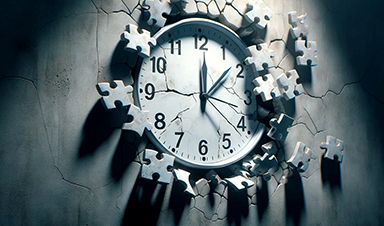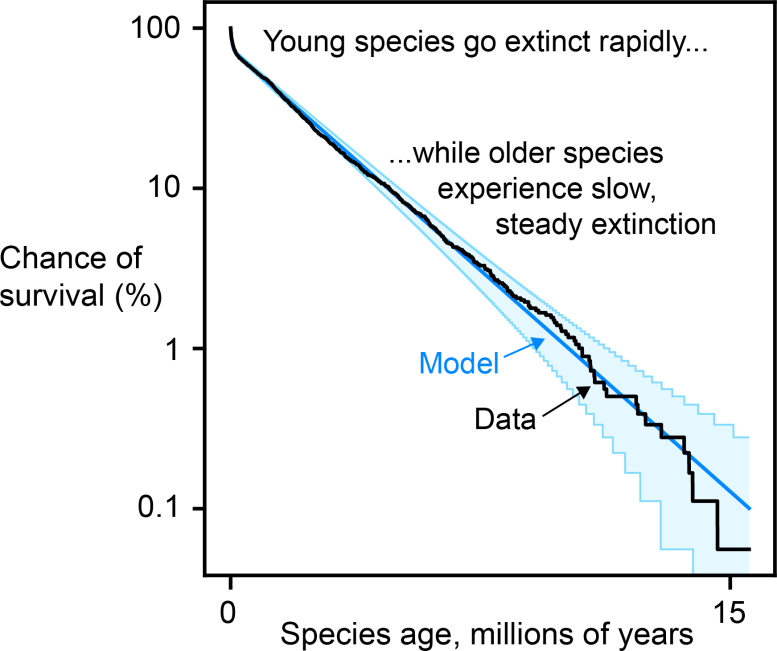A new study led by the University of Kansas might resolve a mystery in the "aging process" in species — or, how a species' risk of going extinct changes after that species appears on the scene.
For years, evolutionary biologists believed older species lacked any real advantage over younger ones in avoiding extinction — an idea known as "Red Queen theory" among researchers.
Revisiting the Red Queen Theory
"The Red Queen theory is that species have to keep running just to stay still, like the character in Lewis Carroll's book 'Through the Looking-Glass,'" said lead author James Saulsbury, a postdoctoral researcher in the Department of Ecology & Evolutionary Biology at KU. "This idea was turned into a kind of ecological theory in the 1970s in an attempt to explain an observation that extinction risk didn't seem to change over the lifespan of species."
Yet the years have not been kind to this theory.
"In the earliest investigations of this phenomenon, species of all ages seemed to go extinct at about the same rate, perhaps just because of the relative crudeness of the evidence available at the time," Saulsbury said. "This made sense under this Red Queen model, where species are constantly competing with other species that are also adapting alongside them."
Questioning and Beyond the Red Queen
But as more data was collected and analyzed in more sophisticated ways, scientists increasingly found refutations of Red Queen theory.
Younger species are generally at greater risk of extinction. A new model from the University of Kansas shows this newer finding of age-dependent extinction while also emphasizing the importance of zero-sum competition in explaining extinction, as in the older Red Queen theory. Credit: Saulsbury et al
"Scientists kept finding instances where young species are especially at risk of extinction," Saulsbury said. "So we had a theory vacuum – a bunch of anomalous observations and no unified way of understanding them."
But now, Saulsbury has led research appearing in the Proceedings of the National Academy of Sciences that may resolve this mystery. Saulsbury and his co-authors showed the relationship between a species' age and its risk of going extinct could be accurately predicted by an ecological model called the "neutral theory of biodiversity."
Neutral Theory's Insights
Neutral theory is a simple model of ecologically similar species competing for limited resources, where the outcome for each species is more or less random.
In the theory, "Species either go extinct or expand from small initial population size to become less vulnerable to extinction, but they are always susceptible to being replaced by their competitors," according to a lay summary of the PNAS paper. By extending this theory to make predictions for the fossil record, Saulsbury and colleagues found that neutral theory "predicts survivorship among fossil zooplankton with surprising accuracy and accounts for empirical deviations from the predictions of Red Queen more generally."
Saulsbury's co-authors were C. Tomomi Parins-Fukuchi of the University of Toronto, Connor Wilson of the University of Oxford and the University of Arizona, and Trond Reitan and Lee Hsiang Liow of the University of Oslo.
While neutral theory might seem to spell curtains for the Red Queen theory, the KU researcher said the Red Queen still has value. Mainly, it proposes the still valid idea that species compete in a zero-sum game against one another for finite resources, always battling for a bigger slice of nature's pie.
"Red Queen theory has been a compelling and important idea in the evolutionary biological community, but the data from the fossil record no longer seems to support that theory," Saulsbury said. "But I don't think our paper really refutes this idea because, in fact, the Red Queen theory and the neutral theory are, in a deep way, pretty similar. They both present a picture of extinction happening as a result of competition between species for resources and of constant turnover in communities resulting from biological interactions."
Relevance and Implications for Conservation
Ultimately, the findings not only help make sense of the forces that shape the natural world but may be relevant for conservation efforts as species face increasing threats from climate change and habitat loss around the globe.
"What makes a species vulnerable to extinction?" Saulsbury asked. "People are interested in learning from the fossil record whether it can tell us anything to help conserve species. The pessimistic side of our study is that there are ecological situations where there isn't a whole lot of predictability in the fates of species; there's some limit to how much we can predict extinction. To some extent, extinction will be decided by seemingly random forces — accidents of history. There's some support for this in paleobiological studies."
He said there has been effort to understand predictors of extinction in the fossil record, but not many generalities have emerged so far.
"There's no trait that makes you immortal or not susceptible to extinction," Saulsbury said. "But the optimistic side of our study is that entire communities can have patterns of extinction that are quite predictable and understandable. We can get a pretty good grasp on features of the biota, like how the extinction risk of species changes as they age. Even if the fate of a single species can be hard to predict, the fate of a whole community can be quite understandable."
Saulsbury added a caveat: It remains to be seen how broadly the neutral explanation for extinction succeeds across different parts of the tree of life.
"Our study is also working on the geological timescale in millions of years," he said. "Things may look very different on the timescale of our own lifetimes."
Reference: "Age-dependent extinction and the neutral theory of biodiversity" by James G. Saulsbury, C. Tomomi Parins-Fukuchi, Connor J. Wilson, Trond Reitan and Lee Hsiang Liow, 27 December 2023, Proceedings of the National Academy of Sciences.
DOI: 10.1073/pnas.2307629121
News
“Great Unified Microscope” Reveals Hidden Micro and Nano Worlds Inside Living Cells
University of Tokyo researchers have created a powerful new microscope that captures both forward- and back-scattered light at once, letting scientists see everything from large cell structures to tiny nanoscale particles in a single shot. Researchers [...]
Breakthrough Alzheimer’s Drug Has a Hidden Problem
Researchers in Japan found that although the Alzheimer’s drug lecanemab successfully removes amyloid plaques from the brain, it does not restore the brain’s waste-clearing system within the first few months of treatment. The study suggests that [...]
Concerning New Research Reveals Colon Cancer Is Skyrocketing in Adults Under 50
Colorectal cancer is striking younger adults at alarming rates, driven by lifestyle and genetic factors. Colorectal cancer (CRC) develops when abnormal cells grow uncontrollably in the colon or rectum, forming tumors that can eventually [...]
Scientists Discover a Natural, Non-Addictive Way To Block Pain That Could Replace Opioids
Scientists have discovered that the body can naturally dull pain through its own localized “benzodiazepine-like” peptides. A groundbreaking study led by a University of Leeds scientist has unveiled new insights into how the body manages pain, [...]
GLP-1 Drugs Like Ozempic Work, but New Research Reveals a Major Catch
Three new Cochrane reviews find evidence that GLP-1 drugs lead to clinically meaningful weight loss, though industry-funded studies raise concerns. Three new reviews from Cochrane have found that GLP-1 medications can lead to significant [...]
How a Palm-Sized Laser Could Change Medicine and Manufacturing
Researchers have developed an innovative and versatile system designed for a new generation of short-pulse lasers. Lasers that produce extremely short bursts of light are known for their remarkable precision, making them indispensable tools [...]
New nanoparticles stimulate the immune system to attack ovarian tumors
Cancer immunotherapy, which uses drugs that stimulate the body’s immune cells to attack tumors, is a promising approach to treating many types of cancer. However, it doesn’t work well for some tumors, including ovarian [...]
New Drug Kills Cancer 20,000x More Effectively With No Detectable Side Effects
By restructuring a common chemotherapy drug, scientists increased its potency by 20,000 times. In a significant step forward for cancer therapy, researchers at Northwestern University have redesigned the molecular structure of a well-known chemotherapy drug, greatly [...]
Lipid nanoparticles discovered that can deliver mRNA directly into heart muscle cells
Cardiovascular disease continues to be the leading cause of death worldwide. But advances in heart-failure therapeutics have stalled, largely due to the difficulty of delivering treatments at the cellular level. Now, a UC Berkeley-led [...]
The basic mechanisms of visual attention emerged over 500 million years ago, study suggests
The brain does not need its sophisticated cortex to interpret the visual world. A new study published in PLOS Biology demonstrates that a much older structure, the superior colliculus, contains the necessary circuitry to perform the [...]
AI Is Overheating. This New Technology Could Be the Fix
Engineers have developed a passive evaporative cooling membrane that dramatically improves heat removal for electronics and data centers Engineers at the University of California San Diego have created an innovative cooling system designed to greatly enhance [...]
New nanomedicine wipes out leukemia in animal study
In a promising advance for cancer treatment, Northwestern University scientists have re-engineered the molecular structure of a common chemotherapy drug, making it dramatically more soluble and effective and less toxic. In the new study, [...]
Mystery Solved: Scientists Find Cause for Unexplained, Deadly Diseases
A study reveals that a protein called RPA is essential for maintaining chromosome stability by stimulating telomerase. New findings from the University of Wisconsin-Madison suggest that problems with a key protein that helps preserve chromosome stability [...]
Nanotech Blocks Infection and Speed Up Chronic Wound Recovery
A new nanotech-based formulation using quercetin and omega-3 fatty acids shows promise in halting bacterial biofilms and boosting skin cell repair. Scientists have developed a nanotechnology-based treatment to fight bacterial biofilms in wound infections. The [...]
Researchers propose five key questions for effective adoption of AI in clinical practice
While Artificial Intelligence (AI) can be a powerful tool that physicians can use to help diagnose their patients and has great potential to improve accuracy, efficiency and patient safety, it has its drawbacks. It [...]
Advancements and clinical translation of intelligent nanodrugs for breast cancer treatment
A comprehensive review in "Biofunct. Mater." meticulously details the most recent advancements and clinical translation of intelligent nanodrugs for breast cancer treatment. This paper presents an exhaustive overview of subtype-specific nanostrategies, the clinical benefits [...]






















